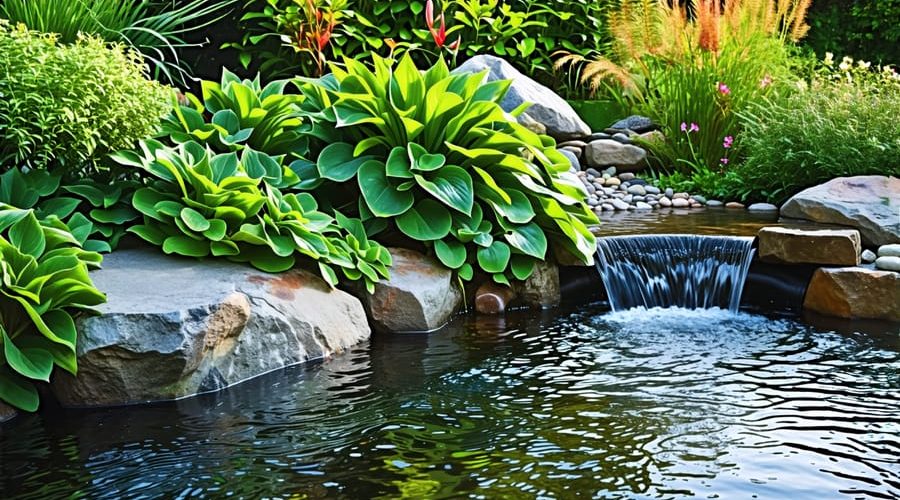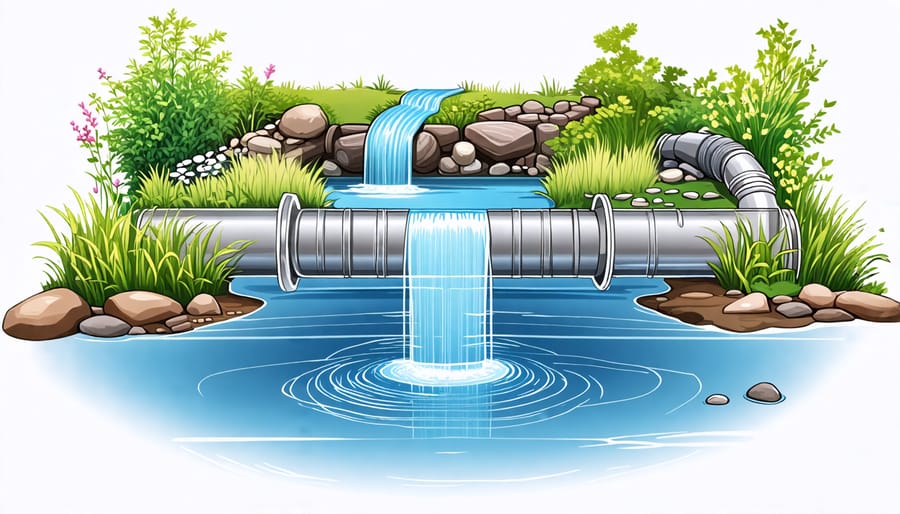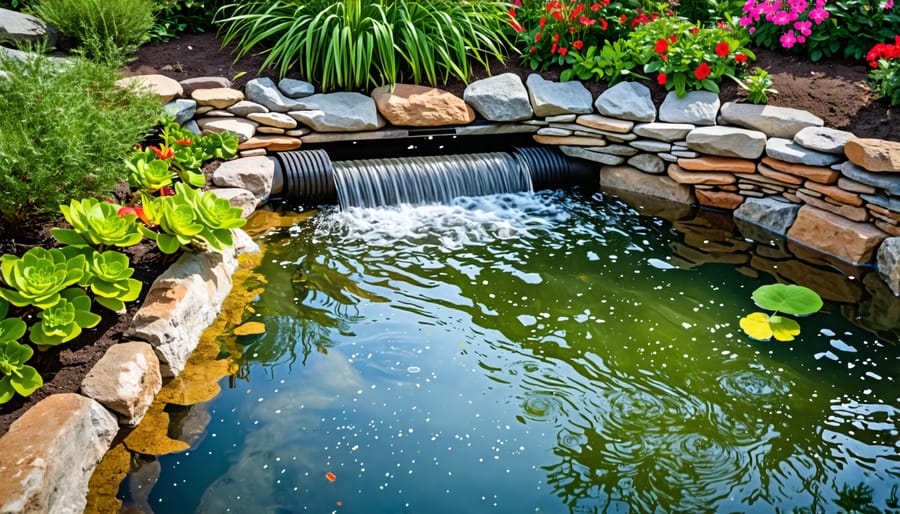
Protect Your Pond with a Perfectly Placed Overflow Drain Pipe
Install a properly sized overflow drain pipe to prevent pond flooding and maintain optimal water levels. Choose a location that allows excess water to drain away from the pond without causing erosion.
Protect the drain pipe intake with a screen or grate to keep fish, debris, and other objects from clogging the pipe. Regularly clean the screen to ensure unobstructed water flow.
Set the overflow pipe at the desired maximum water level for your pond. This level should be several inches below the pond’s edge to provide a safety buffer during heavy rains or when adding water.
Camouflage the exposed portion of the overflow drain pipe with rocks, plants, or other natural elements to maintain your pond’s aesthetic appeal without compromising functionality.
What is a Pond Overflow Drain Pipe?

Key Components
The key components of an overflow drain pipe setup include the drain pipe itself, which is typically made of PVC or other durable material. This pipe is installed at the desired water level of your pond, allowing excess water to flow out when the pond fills up from rain or other sources. A catch basin or French drain at the end of the pipe directs the outflow away from the pond area, preventing erosion and flooding. Proper sizing of the pipe based on your pond’s volume is crucial for effective drainage. Lastly, a screen or guard over the drain inlet keeps debris and fish from entering and clogging the pipe.
How It Works
The pond overflow drain pipe is a simple yet effective solution for maintaining optimal water levels in your pond. When the water reaches a certain height, it enters the drain pipe through an inlet positioned at the desired maximum water level. As more water flows in, it is carried through the pipe and away from the pond, preventing overflow and potential damage to the surrounding area. This automatic process helps to maintain proper pond water levels without the need for constant monitoring or manual intervention. The drain pipe’s outlet can be directed to a suitable drainage area, such as a garden bed or storm drain, ensuring that the excess water is safely dispersed.
Benefits of Installing an Overflow Drain Pipe
Flood Prevention
An overflow drain pipe is a simple but effective solution to prevent pond flooding during heavy rainfall. When installed correctly, it allows excess water to drain out of the pond once it reaches a certain level, typically a few inches below the pond’s edge. This helps maintain a stable water level and protects the pond from overflowing, which can damage the surrounding landscape, erode the banks, and harm fish and plants.
The overflow pipe works by channeling surplus water away from the pond to a designated drainage area, such as a storm drain, dry well, or garden bed. As the water level rises during a downpour, it enters the top of the pipe and flows out of the pond, preventing it from spilling over the edges. This automatic regulation ensures your pond remains within its desired depth range, even during extreme weather events.
Water Conservation
An overflow drain pipe is an essential feature for conserving water in your pond. Rather than allowing excess water to simply run off and go to waste, an overflow directs it to areas of your landscape that can benefit from the extra moisture. This could be a nearby flowerbed, vegetable garden, or even a rain barrel for later use. By strategically positioning the overflow outlet, you ensure that no water is lost unnecessarily. Not only does this help maintain optimal water levels in your pond, but it also supports the responsible use of this precious resource in your outdoor space.
Improved Water Quality
Proper drainage is essential for maintaining optimal pond water quality and clarity. An overflow drain pipe helps prevent water stagnation by allowing excess water to flow out of the pond. This continuous water movement reduces the buildup of harmful nutrients and debris that can lead to algae growth and murky water. By promoting better circulation and oxygenation, an overflow drain pipe creates a healthier environment for fish and plants, resulting in a clearer, more visually appealing pond.

Step-by-Step Overflow Drain Pipe Installation
Planning and Materials
To install a pond overflow drain pipe, you’ll need PVC pipe, a drill, a saw, PVC primer and cement, a level, and a shovel. Consider the pipe size based on your pond’s volume and rainfall. Choose a location for the drain that’s lower than the pond’s edge and away from structures. Mark the pipe’s path, ensuring a slight downward slope for proper drainage. Check local regulations on water discharge and call utility companies before digging. Gather all supplies and double-check measurements prior to starting the installation process.
Excavation and Pipe Placement
To excavate for your pond overflow drain pipe, start by marking the trench path from the pond to the drainage area. Dig the trench about 12-18 inches deep, ensuring it slopes slightly downward away from the pond for proper drainage. A drop of 1 inch per 10 feet of pipe is recommended.
Next, lay a bed of gravel or sand at the bottom of the trench to provide a stable foundation for the pipe. Place the pipe in the trench, beginning at the pond end. Make sure the pipe is level and at the correct height relative to your pond’s water level. The inlet should be positioned just below the maximum desired water level to prevent overflow.
As you lay the pipe, backfill the trench with soil, tamping it down gently to secure the pipe in place. Take care not to dislodge or damage the pipe during this process. Continue until you reach the end of the trench, where the water will drain away from your pond.
Once the pipe is fully installed, cover the exposed end with a screen or grate to keep debris and small animals from entering. Finally, test the overflow drain by filling your pond to the desired level and observing how the excess water flows through the pipe to the drainage area.
Finishing and Testing
Once the pipe is in place, backfill the trench with soil, tamping it down firmly to prevent settling. Install a protective screen or grate over the inlet end to keep debris and animals from entering the pipe. At the outlet, consider using a splash block or rocks to dissipate the water’s energy and prevent erosion. To test the overflow, fill your pond to the brim and observe as the excess water flows through the pipe. Make adjustments as needed to ensure proper function. With your overflow drain complete, you can enjoy your pond with added peace of mind knowing it’s protected from heavy rains and overflow events.
Maintaining Your Pond Overflow Drain Pipe
Regular Cleaning
Regular cleaning of your pond overflow drain pipe is essential to ensure it continues functioning optimally. Debris like leaves, twigs, and algae can accumulate in the pipe and catch basin over time, potentially causing blockages that hinder proper drainage. Make it a habit to periodically inspect and clear out any obstructions, especially during seasons when debris is more prevalent, such as fall and spring.
Use a long-handled net or skimmer to remove floating debris from the catch basin, and consider installing a debris guard or screen to minimize the amount of material entering the pipe. For stubborn algae growth, use a brush or pressure washer to clean the inside of the pipe thoroughly. Consistent maintenance will help prevent serious clogs and keep your overflow system in top shape, protecting your pond from flooding and water quality issues.
Winterizing
If you live in an area that experiences freezing temperatures, it’s important to winterize your pond overflow drain pipe to prevent damage. Before the cold weather sets in, remove any debris that may have accumulated in the pipe over the season. Consider installing a pond de-icer near the overflow drain to keep a small area from freezing over, allowing water to continue flowing out. You can also insulate exposed portions of the pipe with foam pipe covers to provide extra protection against the cold. Taking these simple steps will help ensure your overflow drain remains functional throughout the winter months.
Conclusion
Installing an overflow drain pipe in your pond is a simple yet highly effective way to maintain optimal water levels, prevent flooding, and protect your pond’s ecosystem. By taking the time to properly plan and execute this project, you’ll enjoy a healthier, more stable pond environment that requires less maintenance in the long run. Whether you’re a seasoned water gardener or just starting out, implementing an overflow drain pipe is a smart investment in the longevity and beauty of your pond. So, gather your materials, follow the steps outlined in this guide, and take pride in knowing you’re providing your pond with a vital safety feature that will serve it well for years to come.
